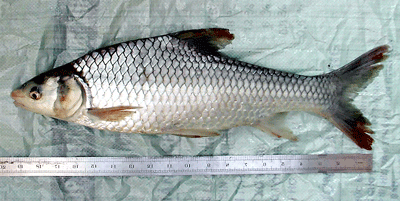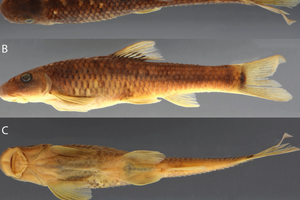Soldier river barb fish and carp are both specialties of the Mekong Delta as well as species in need of urgent protection. In appearance they are similar, having white scales, red dorsal fins, weighing about 5 kilos, with tasty flesh and few bones.
Rare and precious species
According to veteran fishermen in An Huu Commune of Cai Be District in the southern province of Tien Giang, soldier river barb fish weighing about 10 kilos, normally thrive in Tien and Hau Rivers in the Mekong Delta. After the annual flood season, the adult fish migrates upstream to lay eggs after which the baby fish swim downstream to seek food and grow bigger.

Fisherman Sau An, 60, from Hoa Khanh Commune of Cai Be District told that ten years ago it was very common at still high-water levels to see schools of soldier river barbs swim in mid Tien River looking for prey, particularly in the area near the former My Thuan ferry station in Hoa Hung Commune.
Fishermen in these areas usually threw their fishing nets or rods with baits of shrimps and big earthworms deep down into the river.
“Formerly, I was able to catch tens of soldier river barbs, weighing about 7-8 kilos each. Nowadays, only after several tries can I catch one barb weighing a mere 3-5 kilos,” Sau An said regrettably.
Because of their delicious flesh and few bones, they are normally used to prepare many traditional dishes such as fish stewed in coconut juice, sweet and sour fish soup, fish stewed with soya beans, etc. Due to their rarity at the moment, they are sold at a relatively high price of more than VND150,000 per kilo (approx. US$7.19) in markets and VND250,000 – 300,000 per kilo ($12-14.4) in restaurants.
Propagation process
Soldier river barb fish, scientifically called Cyclocheilichthys Enoplos, belongs to the Cyprinidae carp group and normally lives in the river basin mainstream of the lower Mekong, including Tien and Hau River.
In 2000, scientists at the National Breeding Centre for Southern Freshwater Aquaculture under the Research Institute for Aquaculture No.2 launched a scientific project to preserve soldier river barbs in An Thai Trung Commune of Cai Be District, a part of the support programme for freshwater aquaculture initiated by the Ministry of Agriculture and Rural Development with the aid of the Danish government.
The main purpose of the project was to manually propagate soldier river barb, in order to provide one more choice for fish farmers and preserve the gene source of this rare fish.
Thi Thanh Vinh, one of the scientists participating in the project and an efficient contributor to the job of preserving the gene set of freshwater fish, recalled that in 2001, scientists began the process by collecting adult fish from fishermen in the Mekong Delta province of An Giang and Tien Giang.
Since the species die too soon without water, they had to give detailed instructions to fishermen on suitable procedures to adopt and nurture the fish before transporting to the Centre. After living in artificial lakes for a short time, these fish were moved to the lakes at the Centre to get used to still water.
While showing the school of about 200 soldier river barb, the F2 generation, as a positive result of the process up till now, Vinh proudly said that thanks to the experience and enthusiasm of participants in the project, these fish were quite accustomed to their new environment. At the moment, the fish can eat industrial food instead of natural food such as shrimp and minnow.
The first generation of bred fish, about 2000, have been successfully delivered and cared for, to continue the process of propagation. At present, the Centre is carrying out the experimental raise of the F10 generation in public and has received quite positive response. After 12-15 months, these fish can reach a weight of 200-300 grams each.
The private centre to breed fish in Cai Lay District of Tien Giang Province belonging to Tam Vu also accepted care of 5,000 baby fish and then distribute to anyone in need, for breeding purposes.
























